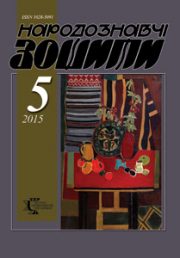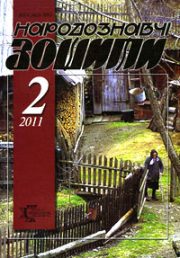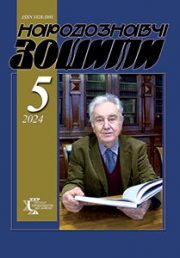The Ethnology Notebooks. 2025. № 5 (185), 1288—1298
UDK[398.332.416:398.8](=161.2)”2022/2024″:801.81
THE VERBAL COMPONENT OF MEMES AS A PHENOMENON OF FOLKLORE
ZAVADSKA Viktoriia
- ORCID ID: https://orcid.org/0000-0002-6411-4926
- Ph. D. in philological sciences, Associate Professor
- of the Department of Ukrainian Language, Literature and Culture,
- Faculty of Linguistics, National Technical University of Ukraine
- «Igor Sikorsky Kyiv Polytechnic Institute»,
- 37, Beresteyskyi Avenue, 03056, Kyiv, Ukraine,
- Contacts: e-mail: ptits@ukr.net
Abstract. The aim of the article is to analyze memes as a folklore phenomenon, that is, to focus on their verbal component; to find out what contributes to their creation and spread, and whether a meme can exist for more than one decade, like any other folklore work.
The article considers memes as a genre of folklore, focusing primarily on the verbal component of memes, which is the subject of the study. The author attempts to prove that the proverbs now incorporated into memes were part of folklore before, and that their acquisition of connotative meaning is linked to current events, while the traditional structure of the meme expression remains unchanged. The collective nature of perception, the disregard for authorship and variability, the use of fixed verbal formulas that are recognizable within society — all this is the evidence of the folkloric nature of memes. Three essential components that make an expression a meme and contribute to its spread are examined in detail: knowledge of the prototext and awareness of the current situation, which is the key to deciphering the connotative meaning by the recipients; a structure of expression traditional for the language community with the possibility of «language play»; emotionality based on aphorism, antithesis, irony, sarcasm, etc.
The author argues that the rise of visual elements in modern memes reflects a natural human tendency to visualize the verbal content. In traditional culture, rituals served as a visual expression of spoken or written words. Today, as information spreads through digital networks, images have taken on this role, effectively visualizing and reinforcing the accompanying text. The methodology of the article is based on analytical interpretation methods.
Keywords: memes, meme expressions, war memes, Ukrainian memes, folklore.
Received 30.08.2025
REFERENCES
- Zhulins’ka M., Smolyar, N. (2015). Internet memes as units of information in cyberspace. Current issues in foreign philology, 2, 66—71. Retrieved from: https://scholar.google.com.ua/scholar?as_q=&as_epq=%D0%86%D0%BD%D1%82%D0%B5%D1%80%D0%BD%D0%B5%D1%82-%D0%BC%D0%B5%D0%BC%D0%B8+%D1%8F%D0%BA+%D0%BE%D0%B4%D0%B8%D0%BD%D0%B8%D1%86%D1%96+%D1%96%D0%BD%D1%84%D0%BE%D1%80%D0%BC%D0%B0%D1%86%D1%96%D1%97+%D1%83+%D0%BA%D1%96%D0%B1%D0%B5%D1%80%D0%BF%D1%80%D0%BE%D1%81%D1%82%D0%BE%D1%80%D1%96&hl=uk [in Ukrainian].
- Bulakh, M. (2020). Features of memes as a means of political advertising. Science and Education a New Dimension. Philology (Issue 216, pp. 7—10). DOI: https://doi.org/10.31174/SEND-Ph2020-216VIII64-01 [in Ukrainian].
- Brodie, Richard. (1996). Virus of the Mind: the new science of the meme. Seattle; Warshawa: Integral Press.
- Zavads’ka, V. (2024). Christmas congratulations 2022—2024: features of poetics. The ethnology notebooks, 1 (175). DOI: https://doi.org/10.15407/nz2024.01.220 [in Ukrainian].
- Durnyev, O., & Lytovchenko, A. (2024).Sociological definition of the concept of «Internet meme»: away from «meme». Sociological Studies, 1 (24), 15—23. DOI: https://doi.org/10.29038/2306-3971-2024-01-12-12 [in Ukrainian].
- Memes as the embodiment of folklore forms. Retrieved from: https://www.youtube.com/watch?v=1-vjdwUeHic [in Uk ra inian].
- Hlukhovtseva, I. On the frequency of use of stable word combinations in Ukrainian Eastern Slobozhansky dialects. Retrieved from: https://nasplib.isofts.kiev.ua/server/api/core/bitstreams/ed87a9db-8c52-4dc8-bd62-38f106645aaf/content [in Ukrainian].
- Frauenfelder, Mark. New book reveals why MAGA cult adores Trump: he’s «openly corrupt, a liar, racist, and sadistic». Retrieved from: https://boingboing.net/2024/07/10/new-book-reveals-why-maga-cult-adores-trump-hes-openly-corrupt-a-liar-racist-and-sadistic.html.
- Tarasova, S., & Shostak, V. (2023). Diachronic study of the pandemic meme. Scientific notes of the V.I. Vernadsky Ternopil National University. Series: Philology. Journalism, 2 (Vol. 34 (73), part 1, pp. 121—128). DOI: https://doi.org/10.32782/2710-4656/2023.2.1/22 [in Ukrainian].
- Shifman, L. (2013). Memes in the Digital Culture. MIT Press. DOI: https://doi.org/10.7551/mitpress/9429. 001.0001.
- Holubovs’ka, I. (2009) The type of culture in the mirror of linguistic phraseology. Language and culture in the new Europe: contacts and identity: collection of scientific works. Kyiv: Vydavnychyy dim Dmytra Buraho [in Ukrainian].
- Drapp, I. (2022). Medvedchuk and cats. Typology of Ukrainian memes about the war. Texty.Org.Ua. 2022.10.05. Retrieved from: https://texty.org.ua/articles/107856/khajmarsy-medvedchuk-i-kotyky-typolohija-memiv-pro-vijnu/ [in Ukrainian].






